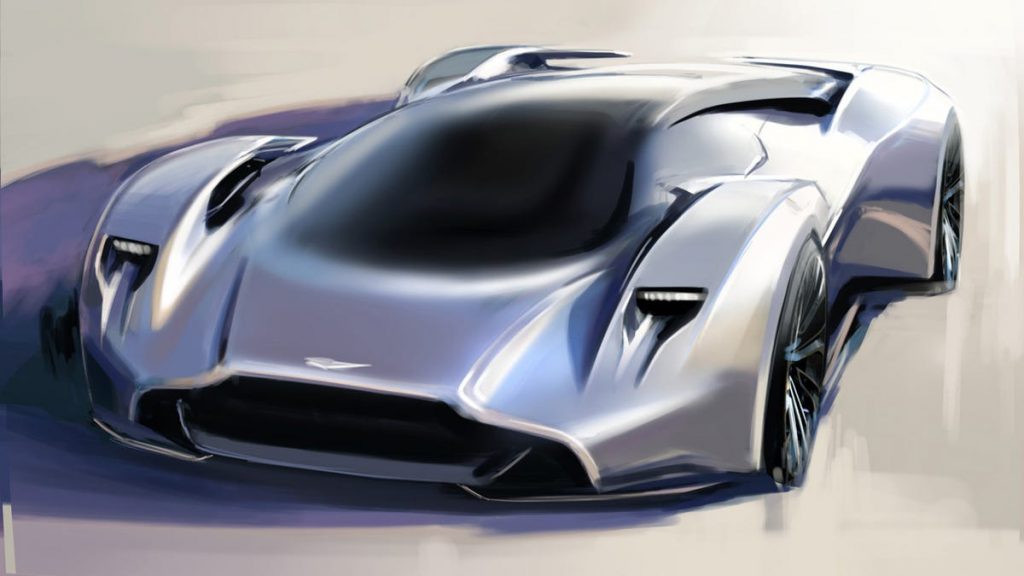Aston Martin's Mid-Engined Marvels Wouldn't Exist Without Video Games

Illustration: Aston Martin
With the Valkyrie and Valhalla garnering so much attention now, it’s easy to forget about Aston Martin’s earlier fantasies of what a mid-engine supercar from the brand might look like. Almost a decade ago, it unveiled the DP-100 — a car designed for Gran Turismo 6. We should all appreciate the DP-100; apparently, if not for that car, Aston wouldn’t be making the Valkyrie and Valhalla now. Or not yet, at least.
This interesting tidbit comes from Marek Reichman, chief creative officer at the British automaker, who recently shed some light on the duo’s history with the Australian outlet CarsGuide:
“That journey started with [Gran Turismo developer Polyphony Digital CEO] Kazunori Yamauchi and we did the DP-100, which was our first virtual mid-engine car. We didn’t have a Valkyrie, we didn’t have a Valhalla, we didn’t have a Vanquish at that time, we had a DP-100,” he said.
“We did it as a GT car and had so many inquiries from customers saying ‘you’re going to make this, you’re going to make this, you’re going to make this’, so I made a model, we took the model to Pebble Beach … I’m not going to rewrite history, but after that came Valkyrie.”
The DP-100 was Aston Martin’s submission for Vision Gran Turismo — an initiative started by GT developer Polyphony Digital to inspire carmakers to design concepts exclusively for the game. According to the game’s website, series producer Kazunori Yamauchi posed the same question to all the manufacturers it works with: “Would you design your rendition of the ideal GT [grand tourer] for us?”
Image: PlayStation Studios
About 10 years later, that ask has culminated in a vast catalog of vehicles, revealing vastly different interpretations of what the “ideal grand tourer” actually is. The Porsche Vision Gran Turismo, which happens to be on the cover of GT7, is a simple, unfettered mid-engine profile designed with electrification in mind, as you’d think it would be for a near-future Porsche. Honda’s interpretation produced a baby NSX I’m still gutted never made production, while BMW’s wound up a last-gen 2 Series that received the old-school DTM treatment.
A few of these cars did end up realized in the flesh, like Audi’s e-tron Vision GT — which brings us back to Aston Martin. Because these concepts aren’t mere 3D models thrown into games. Polyphony really does ask automakers to supply just about as much data as they would a real car. Again, from Reichman:
“If you look chronology of the [Aston Martin] mid-engine car, if you do your research, DP-100 was our car in Gran Turismo to celebrate 15 years in Gran Turismo, and I’m a good friend of Kazunori San, and Kazi phoned me and said ‘we’ve been working together next year 15 years, we should do something special’,” he said.
“And I said ‘what about one of those [DP-100]’? And he said ‘yeah’.
“It’s an incredible process because what Gran Turismo want is not just my sketch, they want CAD, they want to know how heavy is it, what’s the weight distribution, what’s the torque curve?
“It’s not just a ‘here’s a pretty picture’ because they then calibrate the car for the track, etc.
“[It took around] six months as a process because you’ve got to create all the CAD and have to work with the engineer team to verify weight distribution, engine torque, horsepower, etc.
Although it seems like a meaningless detail, the fact that the DP-100 culminated with Aston Martin and Polyphony Digital celebrating 15 years of working together is important to note. Aston Martin was part of the very first Gran Turismo, back in 1997. That game included the DB7 Coupe and Volante; alongside the TVR Griffith and Cerbera, they represented the only British vehicles in GT1’s roster.
Image: PlayStation Studios
The DP-100 was a decidedly less elegant car than either the Valkyrie or the Valhalla, with its stocky, slab-sided silhouette and slender LED headlights hiding in repurposed NACA ducts. Yet, as Reichman says, the concept was the “push” that convinced Aston Martin it needed to join the likes of Porsche, Ferrari and McLaren in the realm of high-performance, mid-engined, motorsport-derived hypercars.
“I couldn’t say they [mid-engined cars] wouldn’t exist without [Gran Turismo], but if you then consider now the world of virtual is just as important as the world of real … did the digital influence the physical? From my perspective, for sure,” he said.
“And would they have existed without [Gran Turismo]? Maybe they would have taken a little bit longer. Maybe DP-100 was the push the world needed to say ‘hey, you can do a cool-looking mid-engine car and have a wing on it and here it is’.”
It’s no secret that success of games like Gran Turismo, Forza Motorsport and the like are the reason why the Impreza WRX, Lancer Evolution and Nissan GT-R commenced sales in North America in the first place. The phenomenon of racing games influencing car culture is nothing new, but it’s encouraging to know it’s still happening, even today.






